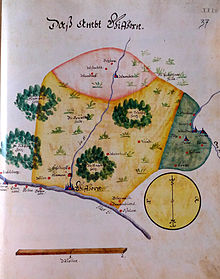Office Gifhorn
The Gifhorn office was a historical administrative area of the Principality of Lüneburg , later of the Kingdom of Hanover and the Prussian Province of Hanover . The seat of administration was Gifhorn Castle .
history
Gifhorn is an old Guelph property and has developed into the center of power for the area on the Upper Aller since the 13th century . Gifhorn Castle was the strongest fortress between the centers of power in Celle and Braunschweig. In 1265 a ducal bailiff is documented for them for the first time, who represented the sovereign in the surrounding Gogerichten zu Rötgesbüttel (Papenteich), Hankensbüttel (Heidemark) and Gifhorn. Since 1409 the Gifhorn office has belonged permanently to the Principality of Lüneburg, but was often pledged until 1520 and temporarily served as a widow's residence. Under Duke Franz it was the residence of a Guelph branch line from 1529 to 1549.
In 1799 the Gografschaft Hankensbüttel and the Vogtei Steinhorst were separated and added to the Isenhagen office . In 1841 the Bailiwick of Wahrenholz came to the Knesebeck office (also to Isenhagen in 1852). In the course of the abolition of patrimonial jurisdiction, the Boldeckerland was incorporated into the Fallersleben office in 1848 . The rest of the office was divided into the offices of Gifhorn and Papenteich (based in Gifhorn) in 1852 when the judiciary and general administration were separated , but were reunited in 1859. Since 1852 the city of Gifhorn has been vacant.
Together with the offices of Fallersleben, Isenhagen and Meinersen as well as the non-official city of Gifhorn, the office of Gifhorn formed the Gifhorn steering committee from 1867 . In 1885 the office was transferred to the district constitution.
scope
When it was abolished (1885), the office comprised the following municipalities:
|
|
|
|
(*) 1852-1859 to the Papenteich office
Bailiffs
- 1784–1788 Georg Johann Christian von Ramdohr (1745–1805) as clerk (2nd official)
- 1818–1833: Friedrich von Uslar, bailiff, from 1828 senior bailiff
- 1834: vacant
- 1835–1858: Johann Conrad Eggers, bailiff, from 1853 senior bailiff
- 1859–1866: Wilhelm Otto Adolf Schneider , bailiff
- (1867) 1868–1872: Carl von Arnim , Amtmann and Kreishauptmann
- 1873–1879: Theodor Eilers , bailiff and district chief
- (1880) 1882–1884, Ernst Mejer, bailiff and district chief
literature
- Theo Bosse: The register of inheritance of the Ambtes Gifhorn from 1669 . Gifhorn 1983
- Iselin Gundermann , Walther Hubatsch : Outline of the German administrative history 1815-1945 . Row A: Prussia, Volume 10: Hanover. Marburg (Lahn) 1981
- Manfred Hamann : Overview of the holdings of the Lower Saxony Main State Archives in Hanover. Third volume: Central and subordinate authorities in the Landdrostei and administrative districts of Hanover, Hildesheim and Lüneburg until 1945. Göttingen 1983, pp. 266–271.
- Heinrich Eggeling: The Gifhorn Office in the Thirty Years' War and in the post-war period , Georg-August-Universität Göttingen 1930, dissertation

